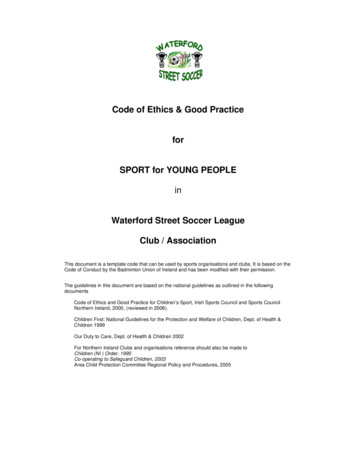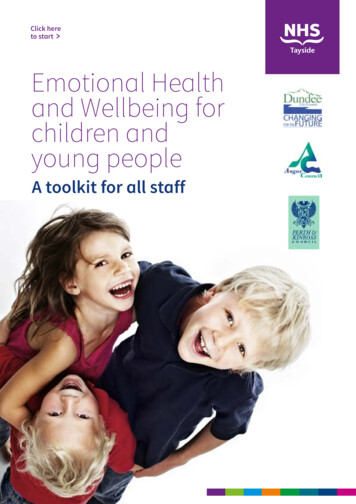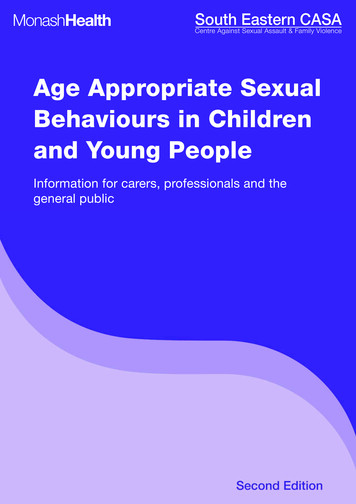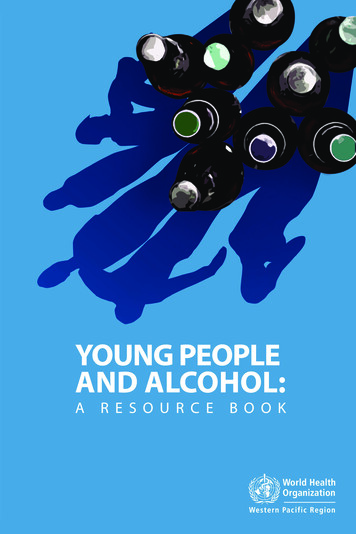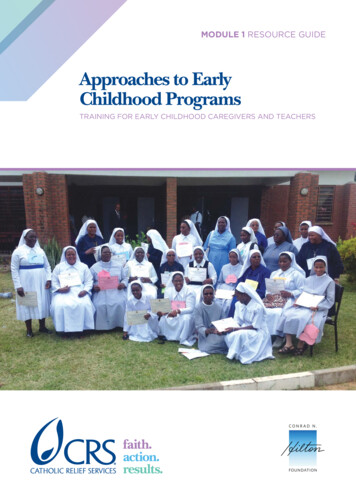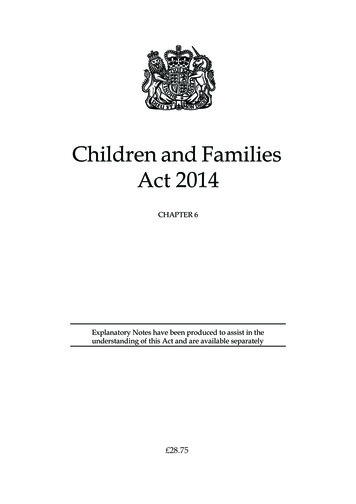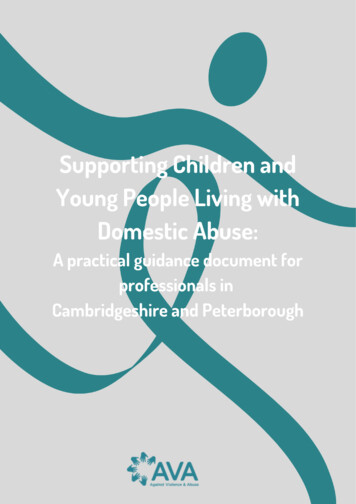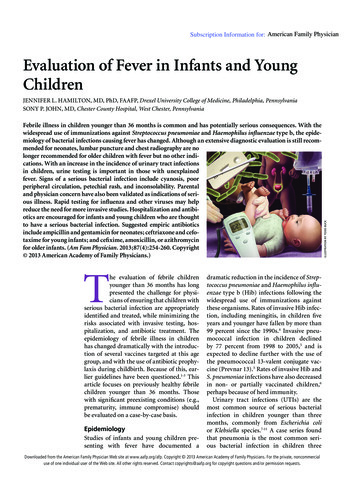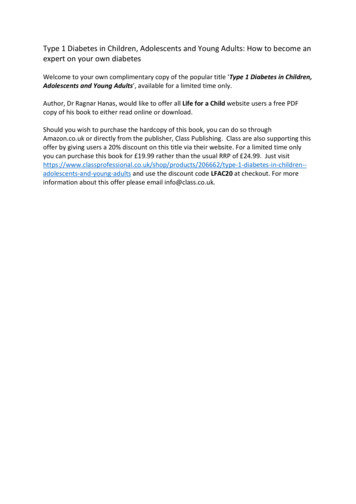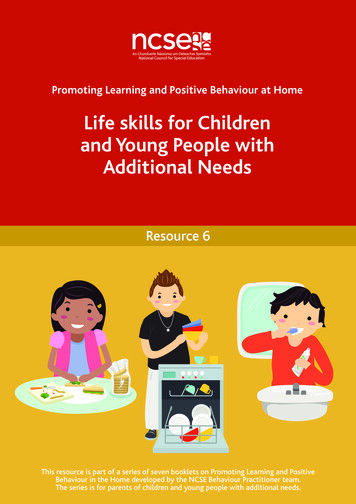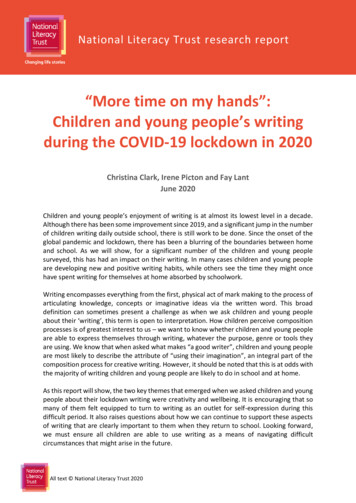
Transcription
National Literacy Trust research report“More time on my hands”:Children and young people’s writingduring the COVID-19 lockdown in 2020Christina Clark, Irene Picton and Fay LantJune 2020Children and young people’s enjoyment of writing is at almost its lowest level in a decade.Although there has been some improvement since 2019, and a significant jump in the numberof children writing daily outside school, there is still work to be done. Since the onset of theglobal pandemic and lockdown, there has been a blurring of the boundaries between homeand school. As we will show, for a significant number of the children and young peoplesurveyed, this has had an impact on their writing. In many cases children and young peopleare developing new and positive writing habits, while others see the time they might oncehave spent writing for themselves at home absorbed by schoolwork.Writing encompasses everything from the first, physical act of mark making to the process ofarticulating knowledge, concepts or imaginative ideas via the written word. This broaddefinition can sometimes present a challenge as when we ask children and young peopleabout their ‘writing’, this term is open to interpretation. How children perceive compositionprocesses is of greatest interest to us – we want to know whether children and young peopleare able to express themselves through writing, whatever the purpose, genre or tools theyare using. We know that when asked what makes “a good writer”, children and young peopleare most likely to describe the attribute of “using their imagination”, an integral part of thecomposition process for creative writing. However, it should be noted that this is at odds withthe majority of writing children and young people are likely to do in school and at home.As this report will show, the two key themes that emerged when we asked children and youngpeople about their lockdown writing were creativity and wellbeing. It is encouraging that somany of them felt equipped to turn to writing as an outlet for self-expression during thisdifficult period. It also raises questions about how we can continue to support these aspectsof writing that are clearly important to them when they return to school. Looking forward,we must ensure all children are able to use writing as a means of navigating difficultcircumstances that might arise in the future.All text National Literacy Trust 2020
We conducted our latest Annual Literacy Survey between January and mid-March 2020.Indeed, the survey closed the week before the UK went into lockdown as a result of theCOVID-19 pandemic, which meant that schools closed for all but children of key workers andthose deemed most vulnerable. This year’s Annual Literacy Survey was our most popular todate, with 58,346 children and young people aged 9 to 18 from 315 UK schools participatingbetween January and March 2020.However, given the suddenly changed environment we found ourselves in, we were also keento capture any possible changes to children and young people’s literacy practices as a resultof lockdown. We therefore re-approached the schools that had previously taken part in ourresearch to see whether they would be interested in surveying their pupils while they werelargely staying home. 4,141 pupils aged 8 to 18 from 51 schools took part in an online surveybetween May and early June 20201.This report outlines our findings on children and young people’s writing before and duringlockdown. Given concerns about the literacy outcomes of disadvantaged children as a resultof the lockdown, we will also produce a separate report exploring this, and we will publishreports focusing on children and young people’s reading practices and engagement withaudio before and during lockdown.To better capture the experiences and opinions of children and young people duringlockdown, the online survey also contained numerous open-text questions, which have beenthemed and analysed to help contextualise findings in this report.Key findings include: 2 in 5 (39.8%) children and young people said at the beginning of 2020 that theyenjoy writing. This is an increase on the number of children and young people fromthe year before (35.8%). Also, 1 in 6 children and young people say that theyenjoyed writing more during lockdown than they had before.After recording the lowest daily writing rate in 2019 since we started asking thequestion in 2010, the percentage of children and young people who say that theywrite outside class on a daily basis has recovered over the past year, increasing from16.5% in 2019 to 21.5% in 2020. Additionally, 1 in 5 (21.4%) said that they had beenwriting more in their free time during lockdown compared with before.Writing in lockdown has given children an outlet for their creativity, imaginationand wellbeing.More children and young people are expressing themselves through creativewriting during lockdown:o 2 in 5 have written more short stories or fiction (39.7%) and letters (39.3%)o 1 in 4 (27.1%) have written more in a diary or journalo 1 in 5 (20.8%) have written more poetryLockdown has given many children the inspiration and conditions to write morecreatively. Children and young people told us that lockdown has:1 The twosurvey samples, though very different in terms of sample size, were comparable in terms of gender, age group andfree school meal splits.All text National Literacy Trust 20202
o Given them more time and space to think and generate ideaso Inspired their writingo Made more digital writing formats available to themWriting creatively during lockdown has helped to support children’s mentalwellbeing:o 2 in 5 (41.3%) children said writing makes them feel better and 1 in 4 (24.8%)said writing helps when they feel sad that they can’t see friends and familyo Children who said that writing makes them feel better were much more likelythan their peers to engage in more creative writing during lockdown: 5 times more likely to write poems (66.5% vs. 13.4%) 4 times more likely to write in a diary or journal (61.9% vs. 14.8%) orto write a short story or fiction (61.1% vs. 15.1%)Enjoyment of writing before and during lockdownIn early 2020, we saw an uplift in the number of children and young people who said that theyenjoy writing either very much (13.5%) or quite a lot (26.4%), compared with the year beforewhen we recorded the lowest level since 2010 (see Figure 1). However, this figure from thebeginning of 2020 still tells us that only a minority of children and young people enjoy writing,with just 2 in 5 children and young people agreeing that they enjoy writing.Figure 1: Percentage of children and young people aged 9 to 18 who enjoyed writing eithervery much or quite a lot from 2010 to early ing lockdown, we asked children and young people whether they now enjoy writing more,the same or less than before lockdown. As can be seen in Figure 2, 1 in 6 said that they enjoywriting more, however this is balanced out by the 1 in 5 who said they enjoy writing less. Forthe majority of children and young people the lockdown made no difference to theirenjoyment of writing, with over 3 in 5 saying that they enjoy it just as much.All text National Literacy Trust 20203
Figure 2: Children and young people’s perception of their writing enjoyment duringlockdown compared with beforeEnjoying writing more than before17.5%Enjoying writing the same as beforeEnjoying writing less than before62.9%19.7%Who enjoys writing more than before?As can be seen in Figure 3, more girls than boys say that they enjoy writing more duringlockdown than before, a dynamic that is in line with previous findings that more girls thanboys say that they enjoy writing2.However, what is interesting is that there is no difference by age group, in that very similarnumbers of children across the ages say that they enjoy writing more now than before. Thisis despite the fact that traditionally writing enjoyment declines with age3, so it is encouragingto see that during lockdown a sizeable percentage of children and young people turned towriting regardless of their age.Figure 3: Children and young people’s perception of their writing enjoyment duringlockdown compared with before by gender and age groupBoys13.6%Girls19.7%Aged 8 to 1118.8%Aged 11 to 1417.6%Aged 14 to 16Aged 16 to 1815.7%18.4%Enjoy more than .6%20.7%63.8%Enjoy the same as before17.8%Enjoy less than ting-201718/ibidAll text National Literacy Trust 20204
Influences on writing enjoyment during lockdownFor those children and young people who say they enjoy writing more during lockdown, thereason for increased writing enjoyment was most often having extra time to write, and tothink about what they were writing (see Figure 4).Figure 4: If you enjoy reading, writing and listening more or less than you did before theend of March, can you tell us why?Comments suggest that having enough time to properly engage with their writing could helpincreased writing enjoyment for some children:“I am enjoying it more because when I am writing I have had more timeto think about what I am going to write.”“I have more time to write so I can therefore indulge in it fully.”“I like writing more because I had more time to do it and realised I likeit.”Associations with schoolworkHowever, many children and young people associate writing with schoolwork, especiallywhen they feel they have a lot to get thorough when learning at home during school closures.They therefore judge writing, in particular, to be something they are less likely to choose todo “for fun”:“I used to write stories for pleasure but I feel like I have spent a lot oftime working on school tasks on my laptop and felt like I should dosomething else.”“I enjoy writing less than before because before I could write my ownpoems and stuff that I like, but now I don't get time to write my ownstuff.”All text National Literacy Trust 20205
Conversely, when children considered writing for enjoyment rather than for school, severalfeel more able to explore themselves as independent writers:“I have had more time to explore my writing style during thecoronavirus break.”“I decided to write a short story and got into the hang of writingtechniques and vocabulary. I'm starting to write a lot more.”“I literally wrote an entire game review for fun.”The digital aspects of writing during lockdown were considered a benefit by some, but not all,children:“I enjoy writing a lot more because I can now type on screens and sendit to my teachers.”“I enjoy writing more because you do it on a laptop.”“I’ve had less things to be physically writing and more online, whichpersonally I feel just aren’t the same, using a pen and a keyboard, soeven though I’m probably writing a similar amount of words, I feel I’mgetting less out of it.”Levels of daily writing in free time before and during lockdown in 2020After recording the lowest daily writing rate in 2019 since we started asking the question in2010, the percentage of children and young people who say that they write outside class ona daily basis has recovered over the past year (Figure 5), increasing by 5 percentage pointsfrom 16.5% in 2019 to 21.5% in 2020.Figure 5: Percentage of children and young people who write daily outside class from 2010to 01520.7%20162017/1820192020All text National Literacy Trust 202018.8%17.3%16.5%21.5%6
As can be seen in Figure 6, 1 in 5 children and young people told us that they had been writingmore during lockdown than before. However, most (3 in 5) had been writing the same amountduring lockdown as before, with 18% saying that they had actually been writing less thanbefore.Figure 6: Children and young people’s perception of their writing frequency duringlockdown compared with beforeWriting more often than before21.4%Writing just as often as before60.5%Writing less often than before18.1%We also wanted to see whether children and young people who say that they now enjoywriting more than before are also the ones who say that they now write more often. As canbe seen in Table 1, nearly 3 in 4 of those who say that they now enjoy writing more thanbefore also say that they write more often, whereas most of those who enjoy writing just asmuch say that they write just as much as before, and the majority of those who say that theyenjoy writing less are also writing less often than before.Table 1: Writing enjoyment by writing frequency during lockdownWrite more oftenWrite just as muchWrite less oftenEnjoy writing more74.1%21.4%4.5%Enjoy writing just asmuch10.5%81.5%8.0%Enjoy writing less9.2%28.9%61.8%Who writes more often now than they had done before?Figure 7 shows that more girls than boys say that they now write more often in their free timethan they had done before lockdown, reflecting previous findings about gender differencesin writing frequency4. Similarly, while more children and young people said that they enjoywriting more during lockdown regardless of age, more children aged 8 to 11 than children andyoung people from other age groups said that they now write more often in their free timethan before lockdown. This reflects general age differences in writing frequency .uk/media/documents/National Literacy Trust report -Children and young peoples writing in 2017-18.pdf5 ibidAll text National Literacy Trust 20207
Figure 7: Children and young people’s perception of their writing frequency duringlockdown compared with before by gender and age groupBoys16.3%63.3%20.4%Girls24.2%58.8%17.0%Aged 8 to 1125.2%56.7%18.1%Aged 11 to 14Aged 14 to 16Aged 16 to 1822.1%17.9%15.3%Write more often than before60.2%17.7%62.3%19.8%62.0%Write as often as before22.7%Write less often than beforeWhy children write more or less frequently during lockdownAs with writing enjoyment, having more time was the most frequently cited reason forincreased time spent writing during lockdown (see Figure 8).Figure 8: If you read, write or listen to something more or less often than you did before theend of March, can you tell us why?All text National Literacy Trust 20208
As noted earlier, for many children and young people, having more time to think and fewerdistractions are associated with greater writing enjoyment and therefore increased writingfrequency, although some were writing less without some of the directions and routines ofthe school setting:“I write more often than before as I have more time to do it. And moretime to think about what to write.”“You can be relaxed and focus on your writing and editing and because no one is there to disturb you.”“I don't write as much as in school we used to do lots of stories.”A rise of creative writing during lockdownWhile a majority of children and young people didn’t change their writing behaviour duringlockdown, quite a few engaged in more creative writing than before. As can be seen in Figure9, 2 in 5 (39.7%) said that they were writing more fiction/short stories either on paper or onscreen during lockdown, while another 2 in 5 said that they had been writing more letters(39.2%) and more in a diary (38.1%) either on paper or onscreen.Figure 9: Children and young people’s writing of six formats during lockdown in 2020Song lyrics12.5%15.7%71.8%25.9%In a 0.7%Short Letters60.7%Yes, wrote more of this on paperYes, wrote more of this on screenNo, I haven't written this more than beforeChildren and young people’s comments suggested that, for many, having additional time andspace to think, and being inspired by this new situation, has had a positive impact on theircreativity:All text National Literacy Trust 20209
“I’m writing more because I have more time thinking, and so mycreative writing is impacted by thoughts and feelings.”“I enjoy writing more than before because it gives me a chance to be inmy own personal space to work, which can really help withconcentration and getting creative things flowing.”“I like writing a lot more because quarantine has inspired me towrite a lot of things, from stories to songs. Normally I don’t get to dothis .now I’m enjoying this time to be creative.”Several children and young people mentioned engaging in long-form writing, includingworking on their own books:“I like writing more because now we have more time to do it in our owntime and think about what we are writing especially since I am nowwriting a novel.”“I have now had more chance to write outside of school time so I'vestarted writing a book which I enjoy.”Another influence on children choosing to write was the range of writing formats available,from diaries and letters to more digitally and socially-inspired writing:“Because in free time we can't go outside so I do writing on a screenand on paper in a diary as well.”“I write more because I write letters to my relatives.”“I'm writing a lot more because I just got my own laptop and I want tomake a story on it as well as write scripts for some characters I madeup.”“I write stories with my friends for fun.”“I prefer writing more now, because I can do it with my friends; we helpeach other out.”Writing as an outlet for mental wellbeing2 in 5 (41.3%) of children and young people said that writing makes them feel better and 1 in4 (24.8%) say that writing helps them when they feel sad because they cannot see family andfriends as a result of lockdown.The connection between writing and emotional states came through in many comments.Some children and young people find creative writing provides an escape from difficultfeelings, while others find that recording their feelings can improve their mental wellbeing:All text National Literacy Trust 202010
“When I’m writing my own story I can block out any worries I have.”“Write more because it helps me through difficult times and anxiety.”“I now write more often in my free time as the lockdown has given me achance to write down my feelings when I want to.”“I have started writing journals and it helps me reflect on the positives.”“I write more because I think it’s a positive way to get a greater mindset. You can talk about a lot of things and express your feelings. I writestories and poems.”Comments also suggest, however, that some children are feeling less able to engage withwriting during the lockdown:“I haven’t been able to think properly to be able to write, due to currentcircumstances with the COVID-19 pandemic.”Overall, more children who agreed with the statement that writing makes them feel betterchose to write creatively across different formats compared with their peers who disagreedwith the statement (see Figure 10). For example, five times as many children who agreed thatwriting makes them feel better said that they now write more poems compared with theirpeers who didn’t agree with the statement. Also, four times as many said that they now writemore in a diary or more fiction than their peers, which reflects some of the comments fromchildren and young people above.Figure 10: Whether children and young people agreed that writing makes them feel betteror not by types of formats written more during lockdownWritten more poems66.5%13.4%Written more in a diaryWritten more fictionWritten more song lyrics61.9%14.8%61.1%15.1%57.3%19.1%Written more lettersWritten more reviewsAgreed that writing makes them feel betterAll text National Literacy Trust 202044.3%31.1%34.1%30.3%Didn't agree that writing makes them feel better11
The role of inspirationCompared with books, which some children and young people were less able to access dueto library closures, writing is less affected by more limited access to resources duringlockdown. However, there is a clear divide between children and young people for whom thesituation has provided a source of writing inspiration, and those who feel the opposite:“Writing is a bit more fun because having inspirational things aroundhelps a lot in making my writing better.”“I enjoy writing more than before because I’ve been writing a sort ofdiary of the events that have been happening and it has made meenjoy writing a lot more.”“I enjoy writing less because there is nothing to write about aseveryone is stuck at home.”To sum upThe lockdown period has been challenging and unsettling so it is heartening to see thatchildren and young people are turning to writing as an expressive outlet during this time. Thetop three formats children and young people are choosing to write: fiction, letters and diariesare particularly insightful as they give us a clear indication of the reasons children are choosingto write. Fiction provides them with a creative outlet, and perhaps a way to create a differentworld; letters enable them to connect with family and friends; and in diaries they can recordthis extraordinary time and explore the emotions they are experiencing.Listening to children’s experiences of writing during lockdown, it is clear that for many, it hasbeen a time of increased creativity, with children writing everything from songs, stories andscripts to even beginning their own novels. This creative response to lockdown should bevalued and supported, as it is likely to help sustain writing skills during school closures.Further, we need to find ways to support these good writing habits to continue at home onceschools reopen.One particularly clear message from the children’s comments was that having more time towrite freely has contributed to their increased enjoyment of writing. Looking ahead, it seemsthat providing time for free writing once back in the classroom could help to sustain thispositive outcome. While there may well be a need for a fast pace of learning, balancing thiswith time for writing that is not prescriptive or exams-focused could be enormously valuableto boost writing enjoyment overall.Importantly, many children also describe how writing has offered a refuge, helping them toexpress their feelings in this difficult time. In times of continued uncertainty, the essential roleof writing as a tool for supporting mental wellbeing should therefore also be recognised andvalued. The popularity of diaries linked with this finding might have been expected but therewas also a strong link between writing for wellbeing and creative formats such as fiction,poems and lyrics which deserves further investigation.All text National Literacy Trust 202012
As we look ahead to a period of processing and recovery, these findings indicate that creativewriting will play an important role. Our programmes, campaigns and policy work onenjoyment and positive behaviours around writing are more crucial than ever.All text National Literacy Trust 202013
Our sincere thanks to Slaughter and May for their generous financial contribution thatenabled us to conduct our Annual Literacy Survey between January and March 2020.About the National Literacy TrustOur charity is dedicated to improving the reading, writing, speaking and listening skills ofthose who need it most, giving them the best possible chance of success in school, work andlife. We run Literacy Hubs and campaigns in communities where low levels of literacy andsocial mobility are seriously impacting people’s lives. We support schools and early yearssettings to deliver outstanding literacy provision, and we campaign to make literacy a priorityfor politicians, businesses and parents. Our research and analysis make us the leadingauthority on literacy and drive our interventions.Literacy is a vital element of action against poverty and our work changes life stories.Visit www.literacytrust.org.uk to find out more, donate or sign up for a free email newsletter.You can also find us on Facebook and follow us on Twitter.Copyright National Literacy Trust 2020. You may report on findings or statistics included in this reportif you accredit them to the National Literacy Trust.Suggested reference for this report is: Clark, C., Picton, I. and Lant, F. (2020). Children andyoung people’s writing during lockdown. London: National Literacy Trust.We will consider requests to use extracts or data from this publication provided that you: Acknowledge that the content is the work of the National Literacy Trust and provideappropriate references in any publications or accompanying publicity;State that any views expressed are yours and not necessarily those of the NationalLiteracy Trust.All text National Literacy Trust 202014
In early 2020, we saw an uplift in the number of children and young people who said that they enjoy writing either very much (13.5%) or quite a lot (26.4%), compared with the year before when we
